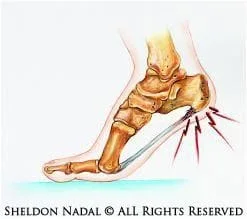Heel Spur Pain, Plantar Fasciitis Treatment by
- What causes heel pain?
- What is plantar fasciitis or heel spur syndrome?
- How do I know if I have plantar fasciitis?
- What can I do at home to relieve the pain of plantar fasciitis?
- What if my heel still hurts?
- What will the podiatrist do?
- I've tried medicine, cortisone, ice, rest, orthotics etc. and I'm losing hope. What else can be done?
- What is endoscopic plantar fasciotomy?
- What are the advantages of endoscopic plantar fasciotomy compared to conventional hospital heel surgery?
- How soon can I return to work following endoscopic plantar fasciotomy?
- What other foot problems do you treat?
View Our Recent Advertisements
What causes heel pain?
One of the most common causes of heel pain is plantar fasciitis or heel spur syndrome.Other causes include gout, arthritis, broken heel bone, infection, foreign bodies (such as stepping on a needle). Your podiatrist can determine the exact cause of your heel pain.
What is plantar fasciitis or heel spur syndrome?
Plantar fasciitis is due to a tight ligament located under the arch and attached to the bottom of the heel. It has become strained and inflamed, often due to a lack of proper support, or due to an injury, or overuse. Over time, the tendon may begin to pull away from its attachment at the heel and a bone spur develops. Generally, the problem is not due to the heel spur, it is due to the inflamed tendon.
How do I know if I have plantar fasciitis?
Usually, you will experience pain at the bottom of the heel, particularly when getting out of bed in the morning or when starting to walk following a period of rest. It tends to feel better after a moderate amount of walking. It may not hurt during a workout but usually hurts more the next day following the workout.
What can I do at home to relieve the pain of plantar fasciitis?
Applying ice to the tender area for short periods may help. Also, try gentle calf stretches. Aspirin may relieve the inflammation. Elevating the heel by putting a soft pad in the shoe under your sore heel may help. Women may feel better in a shoe with a higher heel.
What if my heel still hurts?
It's time to see a podiatrist.
What will the podiatrist do?
The key to relief is to reduce the inflammation and pulling of the tendon at the heel bone. The inflammation may be relieved by anti-inflammatory medicine, physiotherapy such as ultrasound, or a cortisone injection. The pulling of the tendon can be improved temporarily by supporting the arch with adhesive tapings. More long term relief may be obtained by the use of specialized shoe inlays called orthotics. They improve the mechanics of the foot and relax the plantar fascia tendon.
I've tried medicine, cortisone, ice, rest, orthotics etc. and I'm losing hope. What else can be done?
When conservative treatments fail, we consider surgically releasing the tight tendon at its attachment at the heel bone. The procedure can be performed under local anaesthetic using a small instrument called an endoscope. The procedure is called endoscopic plantar fasciotomy.
What is endoscopic plantar fasciotomy?
Under local anaesthetic, a small opening is made on either side of the heel. Through one opening, the endoscope or scope is inserted. The scope is attached to a small camera to allow the podiatrist to see the inflamed tendon on a television monitor. Through the other opening, small tools are used to make a tiny cut in the tendon. This allows the tendon to lengthen, relax, and relieve the tension on the heel bone or heel spur. Thus, the pain is relieved. It is usually not necessary to remove the spur.
What are the advantages of endoscopic plantar fasciotomy compared to conventional hospital heel surgery?
1) Endoscopic plantar fasciotomy uses specialized instruments, including a small scope and camera, so that the work can be done through two very small openings in the skin. Consequently, there is less soft tissue work and less post-operative discomfort.
2) The procedure can be performed painlessly, under local anaesthetic in the comfort of a podiatry office. You can read a magazine, listen to music or watch T.V. while the work is done.
3) Expensive hospital beds are not necessary. This results in substantial savings to the governmental and medical plans.
4) Most people can return to work sooner with this procedure compared to conventional surgery.
How soon can I return to work following endoscopic plantar fasciotomy?
If you sit most of the day at work, you may return within a week. If you stand all day, you need approximately four to six weeks.
What other foot problems do you treat?
In addition to heel and arch pain using endoscopic plantar fasciotomy, I treat bunions, hammertoes, corns and callouses using the minimal incision technique. I also treat warts and ingrown nails using the carbon dioxide laser. All procedures are performed under local anaesthetic in the comfort of my office.
